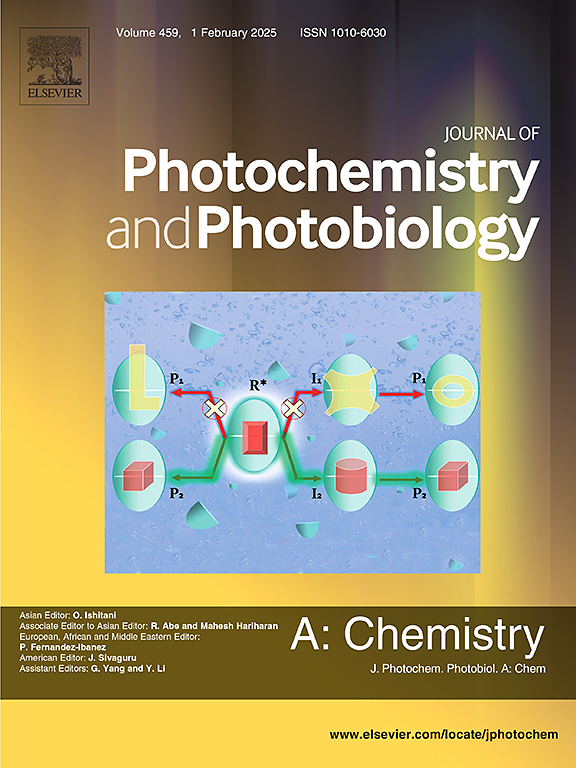Light-driven mechanical motion of a two-dimensional network of polyfluorinated surfactants having azobenzene moiety sandwiched by niobate nanosheets: Effect of pH of intercalation solution
IF 4.1
3区 化学
Q2 CHEMISTRY, PHYSICAL
Journal of Photochemistry and Photobiology A-chemistry
Pub Date : 2025-03-20
DOI:10.1016/j.jphotochem.2025.116402
引用次数: 0
Abstract
A hybrid composed of polyfluoroalkyl azobenzene derivative (C3F-Azo-C6H) and layered niobate nanosheet can undergo interlayer distance change and nanosheet sliding motion upon photo-irradiations. However, such morphology changes are not yet sufficiently controlled, exhibiting somewhat fluctuating results. It is necessary to clarify what kind of intercalation environment promotes the high-order architecture formation suitable for the more efficient photo-induced morphology change. In this study, we have focused on the pH conditions of intercalation solution and analyzed the nanostructure and morphology change of the hybrid fabricated under the basic (pH = 11.0) and the acidic (pH = 2.4) conditions. Intercalating C3F-Azo-C6Hs into the nanosheets under the basic condition afforded a larger interlayer distance as compared with that under the acidic condition. Furthermore, the more substantial interlayer distance change (expansion ratio: 21 %) and the nanosheet sliding (sliding distance: ∼ 200 nm) were successfully induced upon UV–vis photo-irradiations of the hybrid fabricated under the basic conditions, while the hybrid fabricated under the acidic conditions exhibited the smaller changes (interlayer expansion ratio: 0.8 % with unstable/negligible nanosheet sliding). Under the basic conditions, the nanostructure of the C3F-Azo-C6Hs bilayer having non-interdigitation of the terminal alkyl chain of the two-monolayers faced each other in the bilayer caused the substantial morphology changes such as interlayer distance change and nanosheet sliding, whereas the deeply interdigitated terminal alkyl chains in the hybrid fabricated under the acidic conditions caused only a little/negligible morphology change. Factors controlling the drastic changes of the nanostructure derived from the different fabrication conditions have been discussed.

由铌酸盐纳米片夹夹偶氮苯的多氟表面活性剂二维网络的光驱动机械运动:插层溶液pH值的影响
由多氟烷基偶氮苯衍生物(C3F-Azo-C6H)和层状铌酸盐纳米片组成的杂化物在光照射下会发生层间距离变化和纳米片滑动运动。然而,这种形态变化还没有得到充分的控制,表现出一些波动的结果。有必要弄清楚什么样的插层环境促进了适合于更有效的光诱导形态变化的高阶建筑形成。在本研究中,我们重点研究了插层液的pH条件,并分析了在碱性(pH = 11.0)和酸性(pH = 2.4)条件下制备的杂化物的纳米结构和形貌变化。在碱性条件下插入c3f -偶氮- c6hs比在酸性条件下插入c3f -偶氮- c6hs具有更大的层间距。此外,在紫外可见光照射下,在基本条件下制备的杂化材料成功诱导了更大的层间距离变化(膨胀率:21%)和纳米片滑动(滑动距离:~ 200 nm),而在酸性条件下制备的杂化材料表现出较小的变化(层间膨胀率:0.8%,纳米片滑动不稳定/可忽略)。在碱性条件下,c3f -偶氮- c6hs双分子层的端烷基链不互指导致了层间距离变化和纳米片滑动等显著的形貌变化,而在酸性条件下制备的杂化物中端烷基链互指导致的形貌变化很小或可以忽略。讨论了不同制备条件下纳米结构剧烈变化的控制因素。
本文章由计算机程序翻译,如有差异,请以英文原文为准。
求助全文
约1分钟内获得全文
求助全文
来源期刊
CiteScore
7.90
自引率
7.00%
发文量
580
审稿时长
48 days
期刊介绍:
JPPA publishes the results of fundamental studies on all aspects of chemical phenomena induced by interactions between light and molecules/matter of all kinds.
All systems capable of being described at the molecular or integrated multimolecular level are appropriate for the journal. This includes all molecular chemical species as well as biomolecular, supramolecular, polymer and other macromolecular systems, as well as solid state photochemistry. In addition, the journal publishes studies of semiconductor and other photoactive organic and inorganic materials, photocatalysis (organic, inorganic, supramolecular and superconductor).
The scope includes condensed and gas phase photochemistry, as well as synchrotron radiation chemistry. A broad range of processes and techniques in photochemistry are covered such as light induced energy, electron and proton transfer; nonlinear photochemical behavior; mechanistic investigation of photochemical reactions and identification of the products of photochemical reactions; quantum yield determinations and measurements of rate constants for primary and secondary photochemical processes; steady-state and time-resolved emission, ultrafast spectroscopic methods, single molecule spectroscopy, time resolved X-ray diffraction, luminescence microscopy, and scattering spectroscopy applied to photochemistry. Papers in emerging and applied areas such as luminescent sensors, electroluminescence, solar energy conversion, atmospheric photochemistry, environmental remediation, and related photocatalytic chemistry are also welcome.

 求助内容:
求助内容: 应助结果提醒方式:
应助结果提醒方式:


